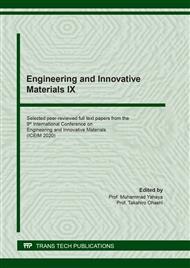p.103
p.109
p.117
p.127
p.133
p.139
p.149
p.155
p.161
Preliminary Study of Fire Damage on Pervious Concrete with Silica Fume and Steel Fiber
Abstract:
Pervious concrete pavement is a porous urban surface. It could reduce runoff capacity, decrease a storm-water detention, reduce the amount of requiring rain drainage pipes, and let rainwater filter into ground and allow groundwater resources to renew in time. Fire damage, could be one of important factors since European countries have been used pervious concrete in buildings construction. This study was conducted to assess the fire damage on pervious concrete with silica fume and steel fiber. The test results find that pervious concrete with 10% silica fume and 2% steel fibers showed the maximum increase in compressive and flexural strengths by 60% and 23% respectively over the control mix while maintaining adequate permeability. It also shows that the flexural strength of pervious concrete with 10% silica fume and 2% steel fiber could reach 45 kg/cm2 strength specification. The high temperature exposure results find that pervious concrete could hardly be detected any crack at the temperature of 700 °Cor 800°C and fire duration of 2 hours. There is some damage on strength after the fire-attack test, the ratio of the residual strength can range from about 20%~60% and it depends on temperature, steel fiber, and silica fume content. By this study of pervious concrete will be valuable for fire safety design and construction of practice.
Info:
Periodical:
Pages:
155-160
Citation:
Online since:
March 2021
Authors:
Price:
Сopyright:
© 2021 Trans Tech Publications Ltd. All Rights Reserved
Share:
Citation:


